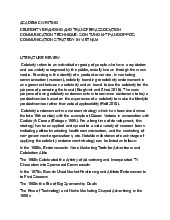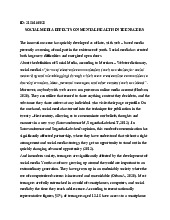

Preview text:
lOMoAR cPSD| 46560390 Introduction
Since the COVID-19 breakout, a significant part of traditional classrooms has been replaced by
virtual ones worldwide. Online school is undeniably a live-saver as the COVID-19 epidemic
shows no signs of ending; even when many inhabitants are fully vaccinated, the situation
deteriorates as the number of infections continues to rise. However, cyberlearning has also
been stated to impact pupils' mental well-being negatively. I strongly agree with this statement.
The pros of online learning
Cyberlearning is an ideal substitute in the current situation since it is safe, effective, and
convenient. Online ones seem to be more beneficial for those unable to attend direct sessions
due to family excuses or financial burdens. Many are accessible on the Internet with more
affordable prices and various contents. Besides, virtual education is also associated with
improved pupils' capacity to comprehend and retain material more quickly.
Psychological impacts of cyber school on students’ mental health
As schools shifted to virtual, unprecedented issues have been addressed. Several studies have
shown that online learning has had severe psychological effects on students, such as anxiety,
fatigue, depression, distress, lack of motivation, and a sense of isolation. There are various
changes in studying circumstances that lead to mental il ness in pupils.
First and foremost: the increase in screen time. For instance, a typical school day lasts about 8
hours, not to mention extra classes; plus, breaks have been shortened in online courses.
Students learning online are supposed to spend such a long time on screen almost every day a
week, which exhausts them both physically and mentally and thus results in and stress.
Second, the interaction between class members is considerably limited, which frequently leads
to isolation among people. Even if students can contact each other via the Internet, there
remain barriers in the process of teamwork. Since they could not engage in social activities
during quarantine, emotional disconnection from friends and classmates is related to emotional
distress, decreased academic performance, and increased stress levels.
Furthermore, the urge to look decent has increased due to online classes. Everyone is staring
directly at a close-up of each other's faces, and there is nowhere to hide. Eventual y, learners
are hyper-aware of their appearance on camera and may feel self-conscious or self-critical
about how they appear on the screen.
Last but not least, previous research has found that students' inability to use learning
technology tools, a lack of IT experience, and a lack of technical backup during virtual classes were the lOMoAR cPSD| 46560390
causes of stress and anxiety during home quarantine. The unstable connection has made many
students fail to absorb course content thoroughly; hence, they would not be able to finish their
assignments by the lecturer's criteria because they could not understand the subject provided
during the lecture. This disorder accounts for the high levels of stress and anxiety in students recently. Conclusion
In summary, online learning can be regarded as a life-saver in maintaining educational
continuity during the lockdown; nonetheless, its drawbacks have shown to be a significant part
of mental health concerns for students. In the long run, the traditional classroom remains the
most suitable and beneficial for all students; hence it should be reintroduced as soon as the situation is under control.




